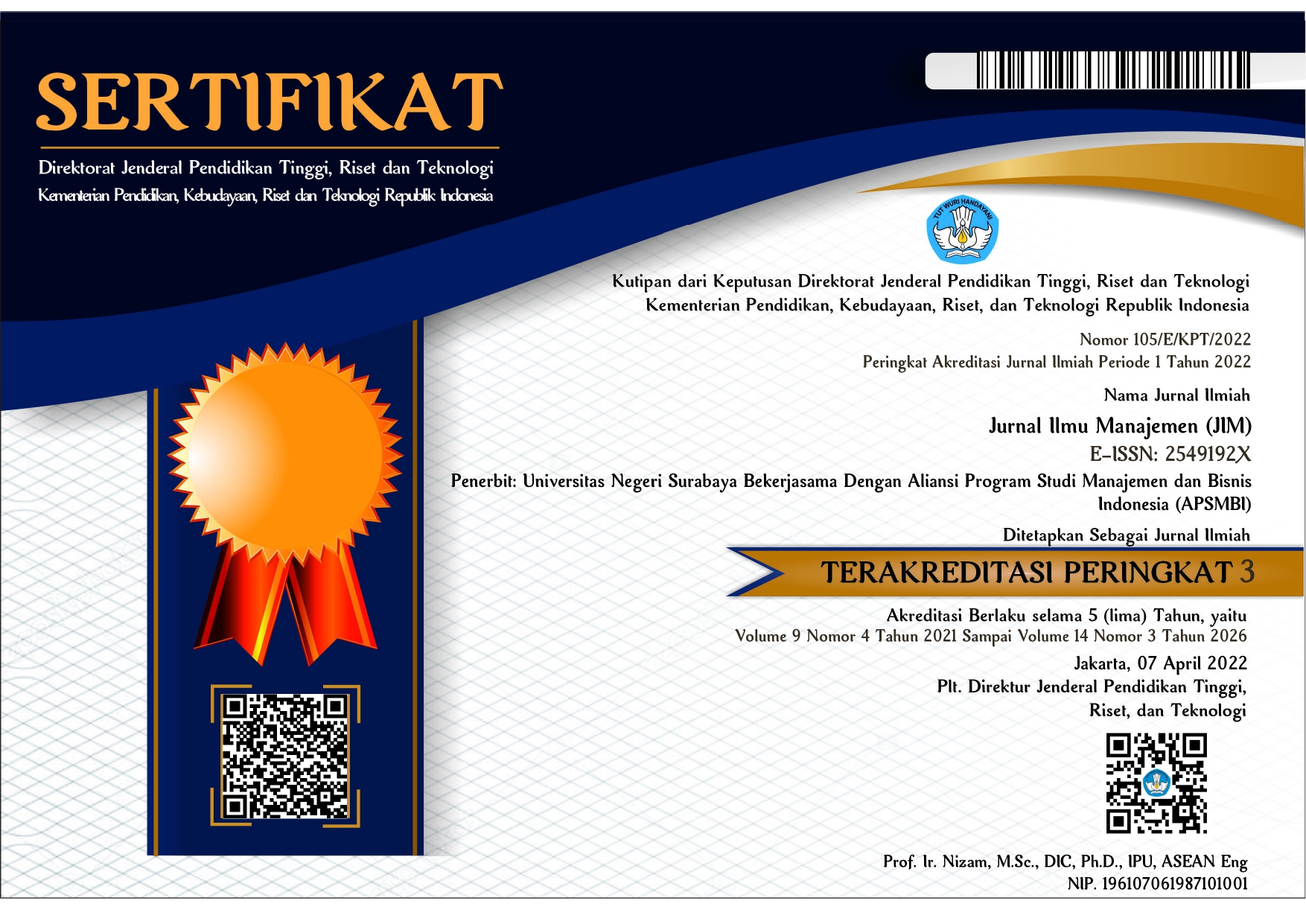Strategi Momentum dan Strategi Volatilitas Momentum pada Saham Indeks LQ 45
DOI:
https://doi.org/10.26740/jim.v9n4.p1308-1318Keywords:
loser portfolio, momentum strategy, momentum volatility strategy, volatility, winner portfolioAbstract
This study looks at the return of the momentum strategy and the momentum volatility strategy of stocks listed on the LQ 45 Index for the 2010-2019 period. The method used in this research is the method of Jagedeesh and Titmant (1993) and Malin and Borhold (2011). Winning portfolios are formed by buying stocks with the best past return performance and selling stocks with past poor returns for a momentum strategy. Meanwhile, the loser portfolio is created by buying stocks with bad returns and selling stocks with good returns in the past. A momentum and volatility type is used in forming a portfolio of winners and losers for a momentum volatility strategy. Formations and observations were used 3,6 and 12 months—return momentum when the loser minus an optimistic winner. Significant momentum is determined by a one-sample t-test using SPSS 21. The study did not find returns from all momentum strategies statistically significant on stocks with LQ 45 Index for the 2010-2019 period. This result explains that the LQ 45 index is already in a weak form of efficient market condition. Investors cannot use this strategy to obtain excess returns when transacting on the LQ 45 index.
References
Arfianto, D., & Maharani, E. (2017). Analisis Pengaruh Momentum , Trading Volume dan Size Terhadap Disposition Effect dan Return Aplikasi Cross Sectional Regresion. Diponegoro Journal Of Management. 6 (1), 139-153
Barroso, P., & Santa-Clara, P. (2015). Momentum has its Moments. Journal of Financial Economic, 116 (1), 111-120.
Blitz, D., Huij, J., & Martens, M. (2011). Residual Momentum. Journal of Empirical Finance. 18, (3), 506-521
Bhootra, A.(2018), "Gross Profitability and Momentum" Managerial Finance, 44(8), 992-1011. https://doi.org/10.1108/MF-11-2017-0444
Carhart, M. M. (1997). On persistence in Mutual Fund Performance. The Journal of finance, 52(1), 57-82.
Chopra, N., Lakonishok, J., & Ritter, J. (1992). Measuring Abnormal Performance: Do Stocks Overreact? Journal of Financial Economics, 31(2), 235-268.
Dhankar, S, R. (2017). Momentum Anomaly: Evidence From The Indian Stock Market. Journal of Advances in Management Research. 14 (1), 3-22
Du, Ding. (2012). Momentum and Behavioral Finance. Managerial Finance. 38(4). 364 - 379
Fama, F. E., & French, R. K. (1993). Common Risk Factor in The Returns on Stock and Bonds. Journal of Financial Economics. 33, 3-56.
Grundi., & Martin, S. J. (2001). Understanding The Nature of The Risk and The Source of The Reward to Momentum Investing. The Review Of Financial Studies. 14(1), 29-78.
PT Bursa Efek Indonesia.2021. Indeks. (https://www.idx.co.id/produk/indeks, diakses pada 35 Maret 2021)
Jiang, Y., Hua, X., & Chen, Q. (2015). Contrarian strategy and herding behaviour in the Chinese stock market. The European Journal ofFinance. 24(16), 1552-1568
Lakonishok, J., Jegadeesh, N., & Chan, L. K. C. (1996). Momentum Strategies. Journal of Finance, 51(5),1681-1713. https://doi.org/10.1111/j.1540-6261.1996.tb05222.x
Maio, P., Detzel, A., & Barroso, P. (2016). Managing the Risk of The Low-risk Anomaly. SSRN Electronic Journal. DOI:10.2139/ssrn.2876450
Malin, M., & Bornholt, G. (2011). Using Volatility to Enhance Momentum Strategies. JASSA The Finsia Journal Of Applied Finance. 2, 16-21
Malkiel, G, B., & Xu, y. (2003). Investigating the Behavior of Idiosyncratic Volatility. The Journal of Business. 76 (4), 613-645
Moreira, A., & Muir, T. (2017). Volatility-Managed Portfolios. The Journal of Finance. 72 (4), 1611-1643
Moskowitz, J. T., & Daniel, K. (2016). Momentum Crash. Journal of Financial Economic, 122, 221-247.
Nanda., & Adrianto. (2019). Abnormal Return Momentum pada Saham Syariah di Jakarta Islamic Indeks. Jurnal Ilmiah Mahasiswa Ekonomi Manajemen. 4 (4), 773-785.
Rhee, G. H., Nakano, S., & Chang. (2018). Residual Momentum in Japan. Journal of Empirical Finance 45, 283-299.
Saputro, N., & Badjra, B. (2016). Kinerja Portofolio Saham Berdasarkan Strategi Investasi Momentum pada Industri Manufaktur. E-Jurnal Manajemen Unud, 5(1), 623-649
Scrimgeor, F., Locke, S., & Gupta, K. (2013). Profitability of Momentum Returns Under Alternative Approaches. International Journal of Managerial Finance, 9(3), 219- 246.
Tanna, S., & Nnadi, M. (2017). Accounting analyses of momentum and contrarian strategies in emerging markets. Asia-Pacific Journal of Accounting & Economics.26 (4), 457-477. https://doi.org/10.1080/16081625.2017.1284596
Wiastuti, S, R., & Maharani, S. (2015). Fenomena Market Overreaction di Bursa Efek Indonesia. Management Analisys Journal.4 (1), 30-38.
Wibowo, S, S., & Mosii, L, R. (2019). The Profitability of Momentum Strategies: A Study Of Indonesian Stock Exchange. Indonesian Capital Market Review.11,15-29.
Yavuz., & Conrad. (2016). Momentum and Reversal: Does What Goes Up Always Come Down? Review of Finance, 21(2), 555-581. 10.1093/rof/rfw006
Downloads
Published
How to Cite
Issue
Section
License
Copyright (c) 2021 Jurnal Ilmu Manajemen

This work is licensed under a Creative Commons Attribution-NonCommercial 4.0 International License.
 Abstract views: 702
,
Abstract views: 702
, PDF Downloads: 1200
PDF Downloads: 1200










